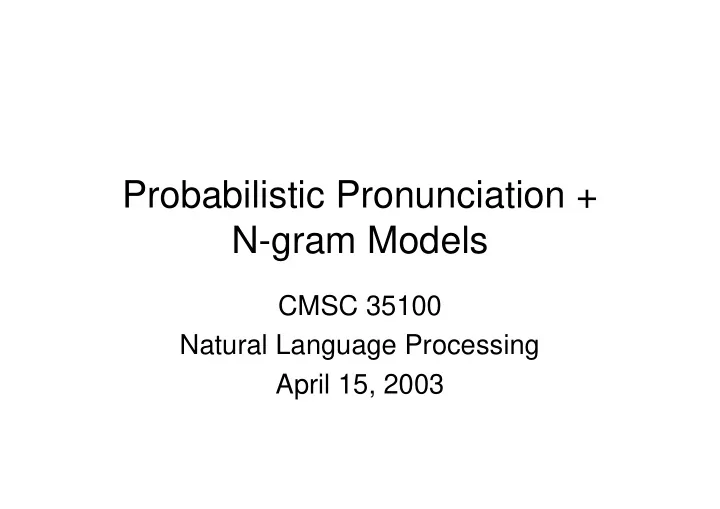

Probabilistic Pronunciation + N-gram Models CMSC 35100 Natural Language Processing April 15, 2003
The ASR Pronunciation Problem Given a series of phones, what is the most probable word? Simplification: Assume phone sequence known, word boundaries known Approach: Noisy channel model Surface form is an instance of lexical form that has passed through a noisy communication path Model channel to remove noise, find original
Bayesian Model • Pr(w|O) = Pr(O|w)Pr(w)/P(O) • Goal: Most probable word – Observations held constant – Find w to maximize Pr(O|w)*Pr(w) • Where do we get the likelihoods? – Pr(O|w) – Probabilistic rules (Labov) • Add probabilities to pronunciation variation rules – Count over large corpus of surface forms wrt lexicon • Where do we get Pr(w)? – Similarly – count over words in a large corpus
Weighted Automata • Associate a weight (probability) with each arc - Determine weights by decision tree compilation or counting from a large corpus 0.54 ax aw 0.68 0.85 0.3 t end 0.12 0.16 start b 0.15 0.2 0.63 ix ae dx 0.37 Computed from Switchboard corpus
Forward Computation • For a weighted automaton and a phoneme sequence, what is its likelihood? – Automaton: Tuple • Set of states Q: q0,…qn • Set of transition probabilities between states aij, – Where aij is the probability of transitioning from state i to j • Special start & end states – Inputs: Observation sequence: O = o1,o2,…,ok – Computed as: • forward[t,j] = P(o1,o2…ot,qt=j| λ )p(w)= Σ i forward[t-1,i]*aij*bjt – Sums over all paths to qt=j
Viterbi Decoding • Given an observation sequence o and a weighted automaton, what is the mostly likely state sequence? – Use to identify words by merging multiple word pronunciation automata in parallel – Comparable to forward • Replace sum with max • Dynamic programming approach – Store max through a given state/time pair
Viterbi Algorithm Function Viterbi(observations length T, state-graph) returns best-path Num-states<-num-of-states(state-graph) Create path prob matrix viterbi[num-states+2,T+2] Viterbi[0,0]<- 1.0 For each time step t from 0 to T do for each state s from 0 to num-states do for each transition s’ from s in state-graph new-score<-viterbi[s,t]*at[s,s’]*bs’(ot) if ((viterbi[s’,t+1]=0) || (viterbi[s’,t+1]<new-score)) then viterbi[s’,t+1] <- new-score back-pointer[s’,t+1]<-s Backtrace from highest prob state in final column of viterbi[] & return
Segmentation • Breaking sequence into chunks – Sentence segmentation • Break long sequences into sentences – Word segmentation • Break character/phonetic sequences into words – Chinese: typically written w/o whitespace » Pronunciation affected by units – Language acquisition: » How does a child learn language from stream of phones?
Models of Segmentation • Many: – Rule-based, heuristic longest match • Probabilistic: – Each word associated with its probability – Find sequence with highest probability • Typically compute as log probs & sum – Implementation: Weighted FST cascade • Each word = chars + probability • Self-loop on dictionary • Compose input with dict* • Compute most likely
N-grams • Perspective: – Some sequences (words/chars) are more likely than others – Given sequence, can guess most likely next • Used in – Speech recognition – Spelling correction, – Augmentative communication – Other NL applications
Corpus Counts • Estimate probabilities by counts in large collections of text/speech • Issues: – Wordforms (surface) vs lemma (root) – Case? Punctuation? Disfluency? – Type (distinct words) vs Token (total)
Basic N-grams • Most trivial: 1/#tokens: too simple! • Standard unigram: frequency – # word occurrences/total corpus size • E.g. the=0.07; rabbit = 0.00001 – Too simple: no context! • Conditional probabilities of word sequences n = n P w P w P w w P w w P w w 2 ( ) ( ) ( | ) ( | )... ( | ) n 1 n 1 2 1 3 1 1 ∏ − = k P w k w 1 ( | ) 1 = k 1
Markov Assumptions • Exact computation requires too much data • Approximate probability given all prior wds – Assume finite history – Bigram: Probability of word given 1 previous • First-order Markov – Trigram: Probability of word given 2 previous • N-gram approximation − − ≈ n n P w w P w w 1 1 ( | ) ( | ) − + n n n N 1 1 n ∏ n ≈ P w P w w ( ) ( | ) − k k Bigram sequence 1 1 k = 1
Issues • Relative frequency – Typically compute count of sequence • Divide by prefix C w w ( ) = P w w − n n 1 ( | ) − n n 1 C w ( ) − n 1 • Corpus sensitivity – Shakespeare vs Wall Street Journal • Very unnatural • Ngrams – Unigram: little; bigrams: colloc; trigrams:phrase
Recommend
More recommend